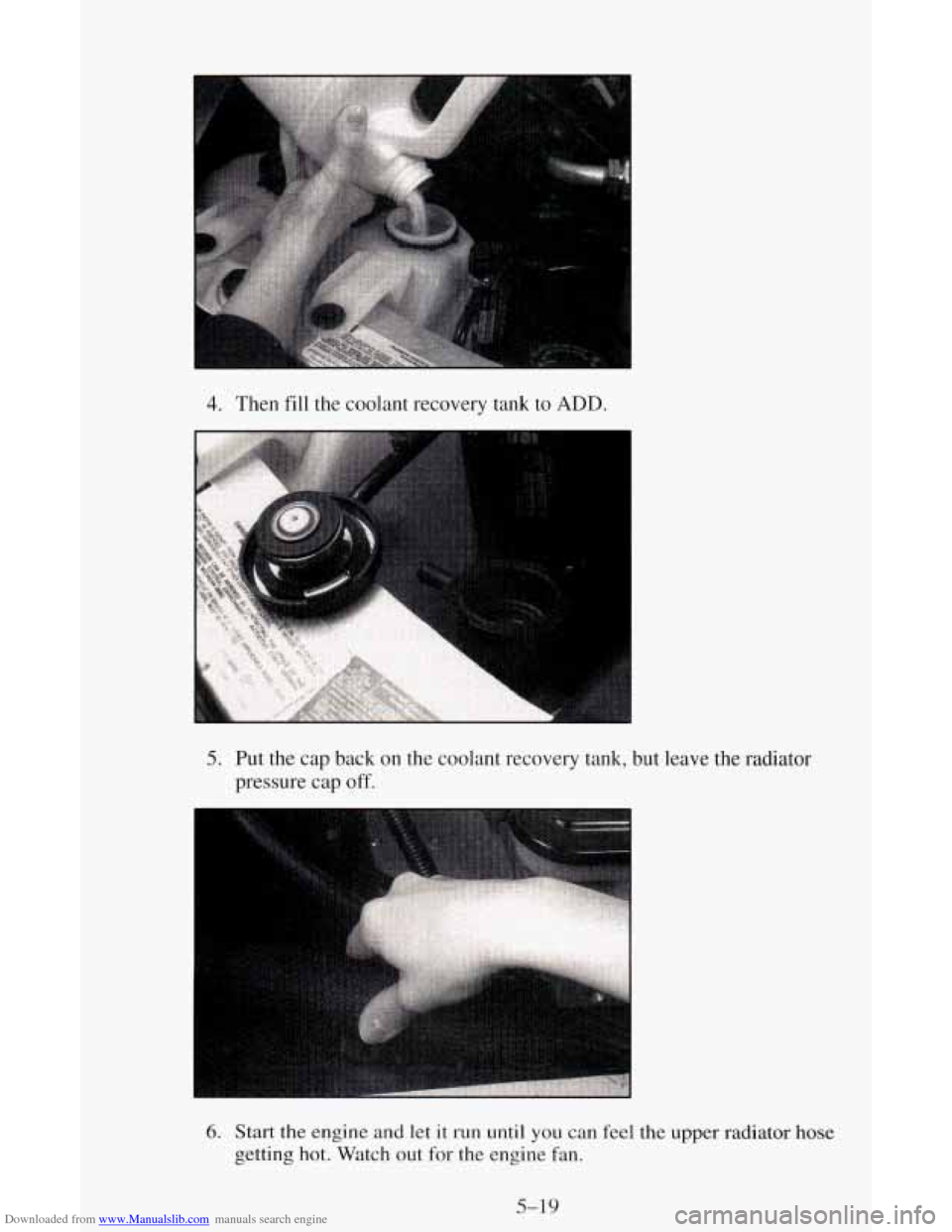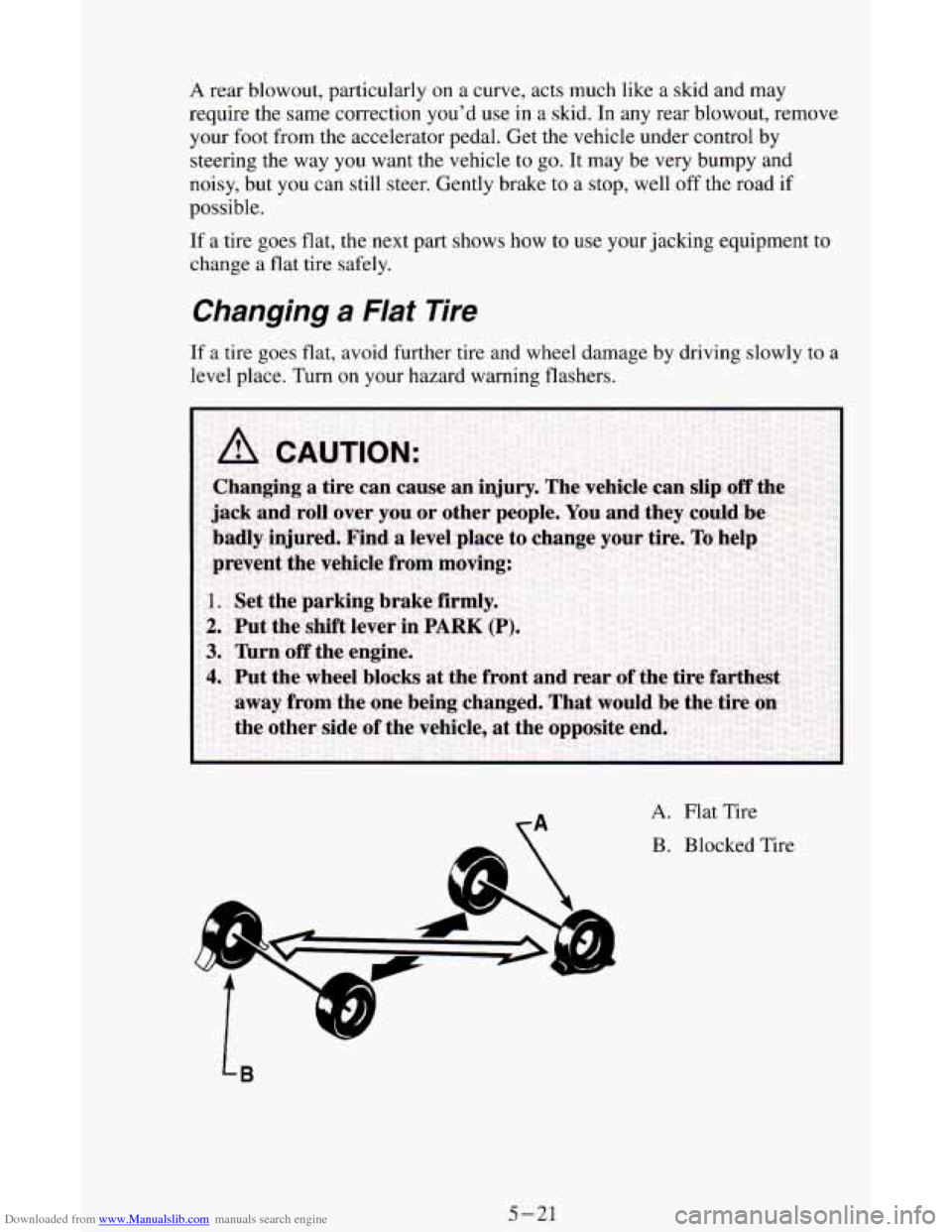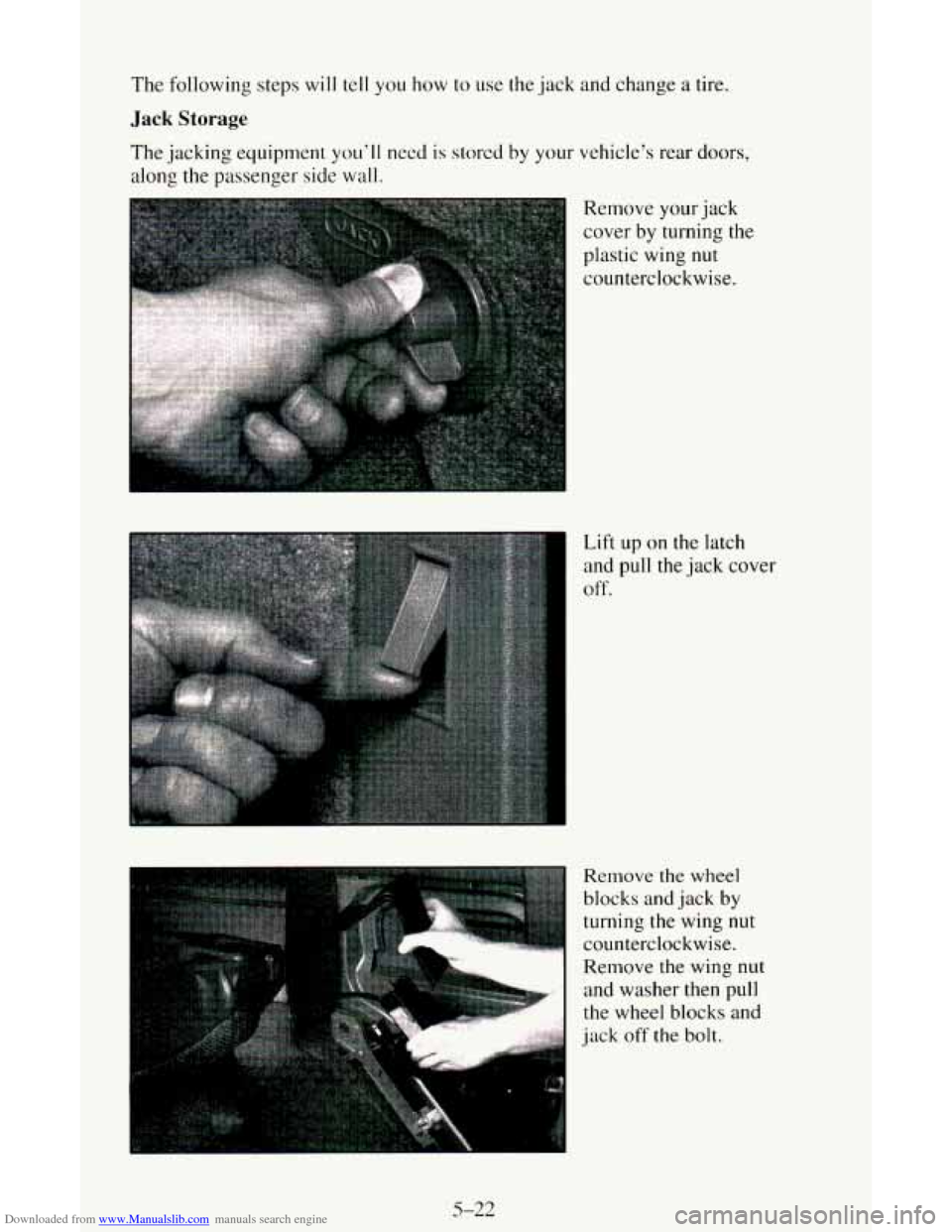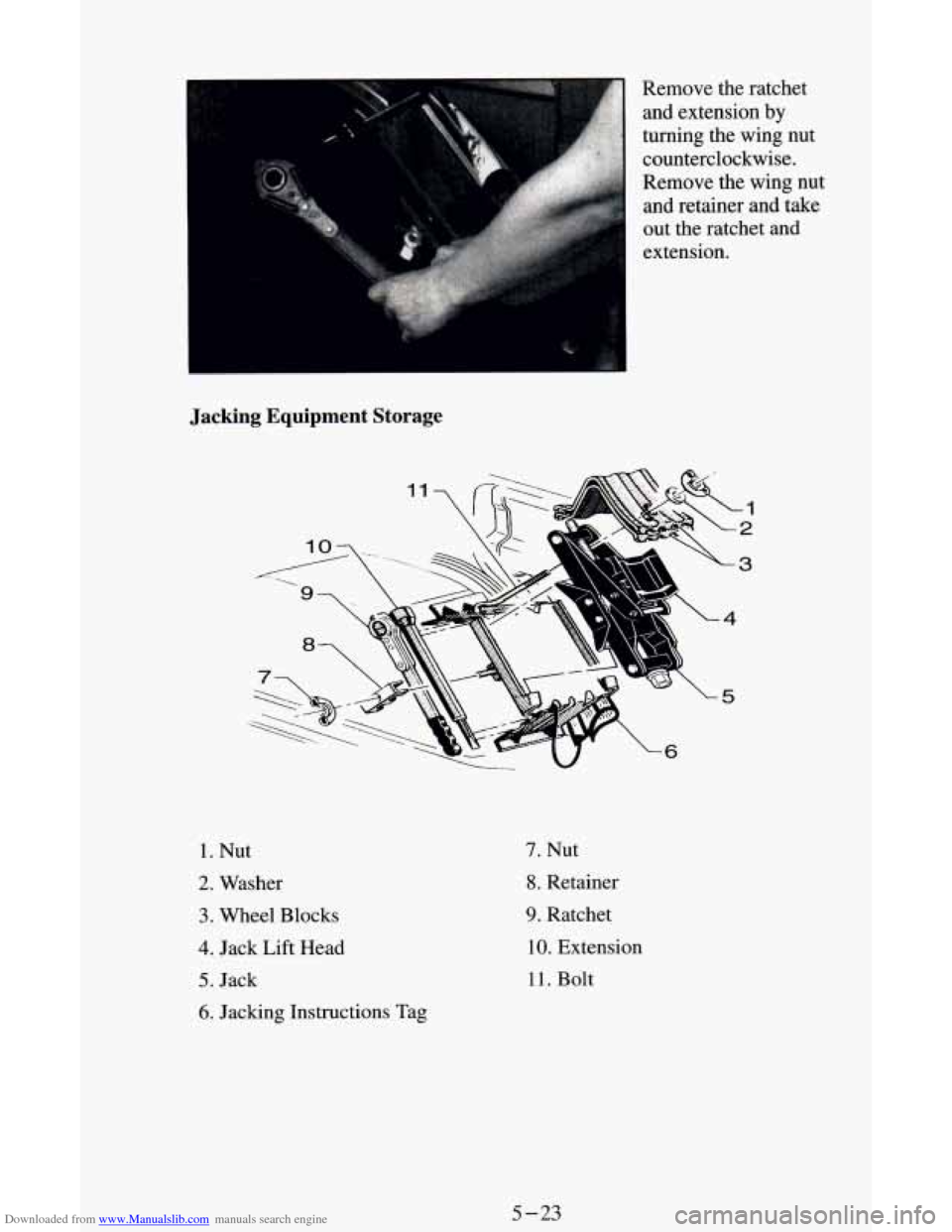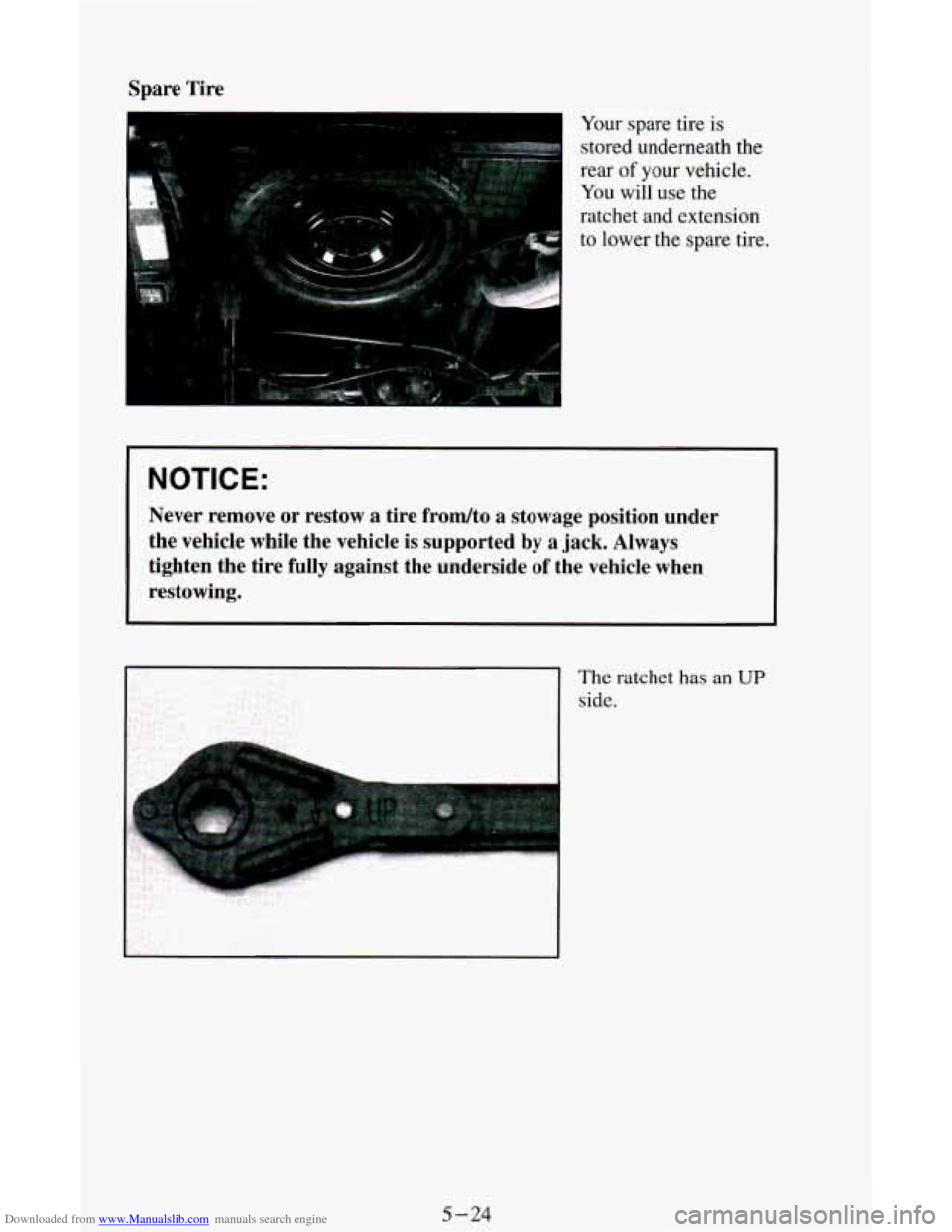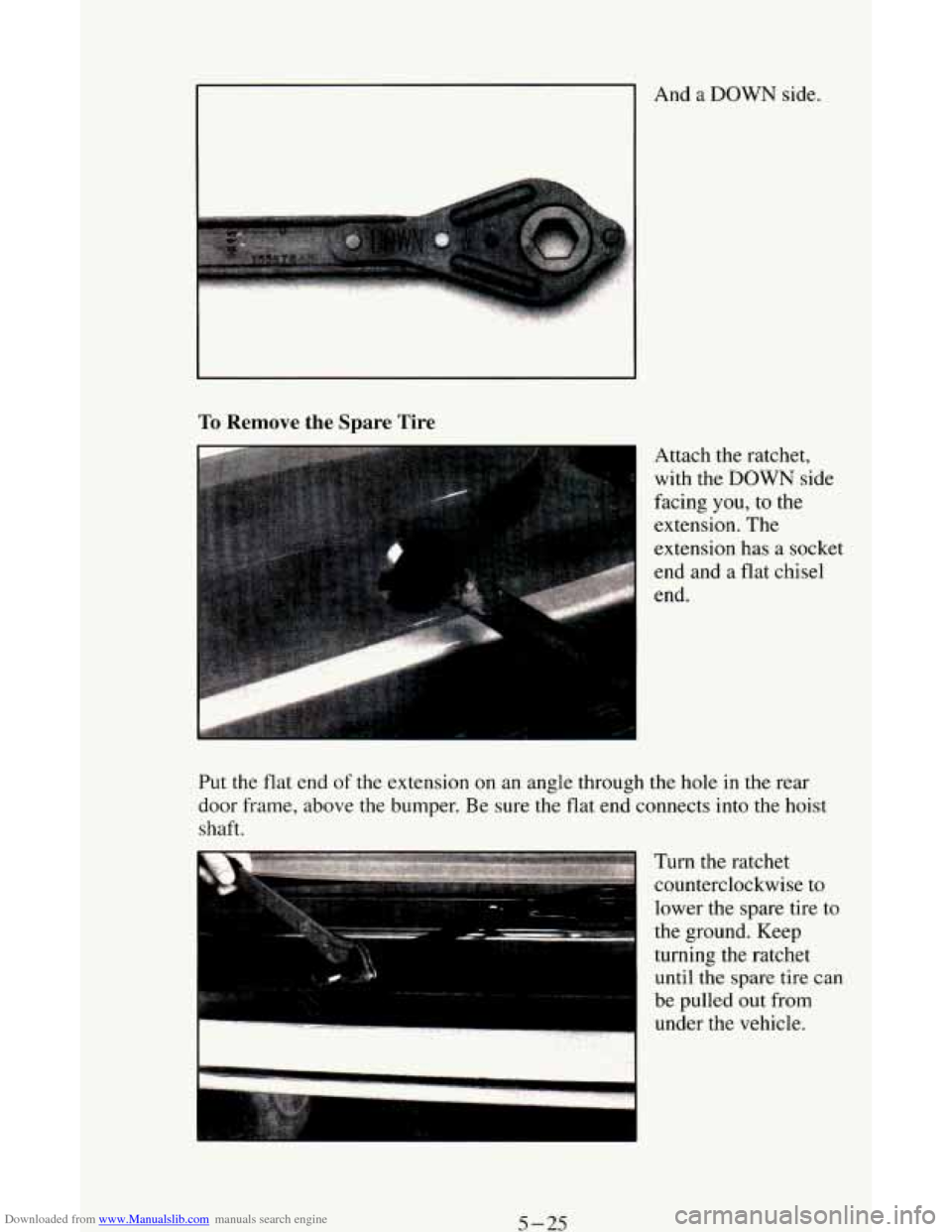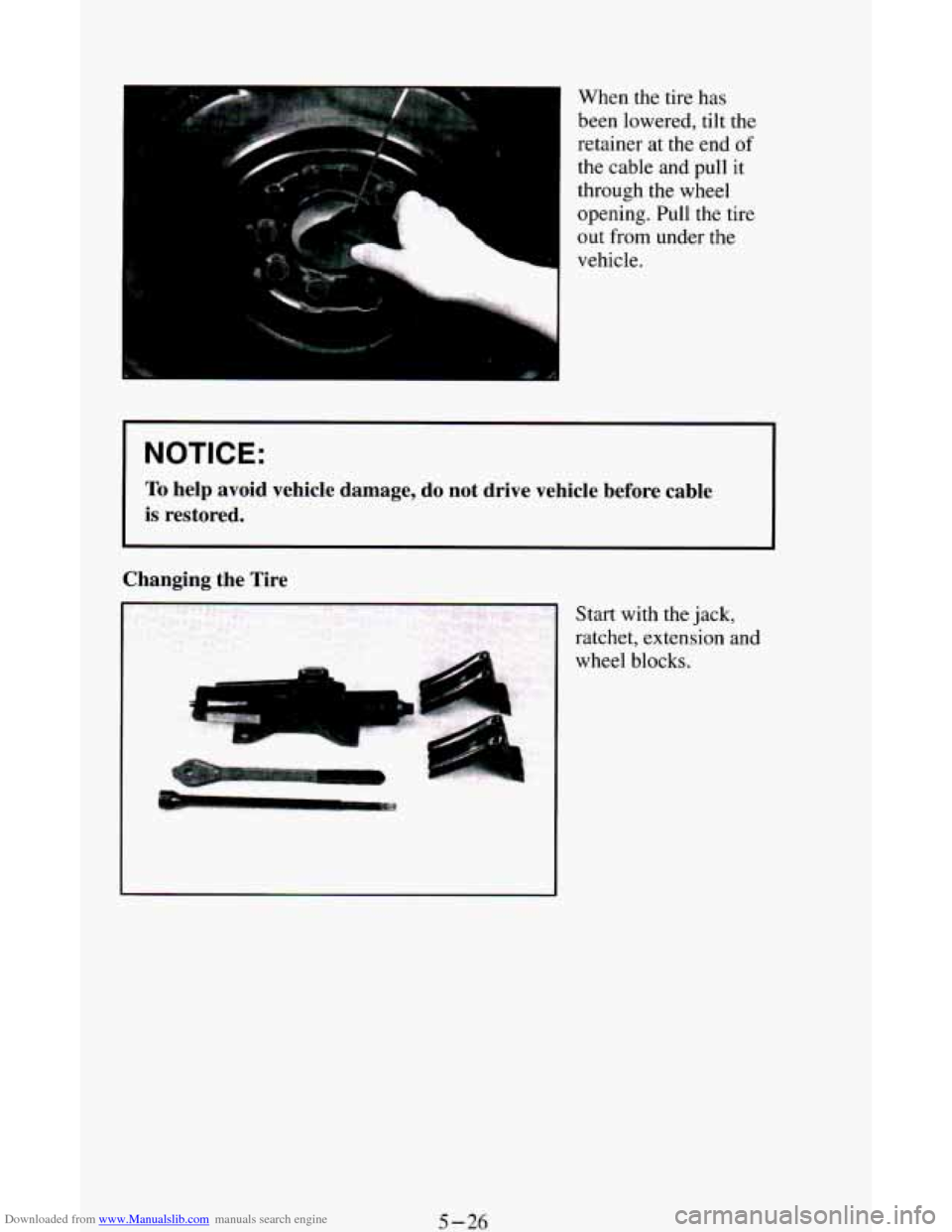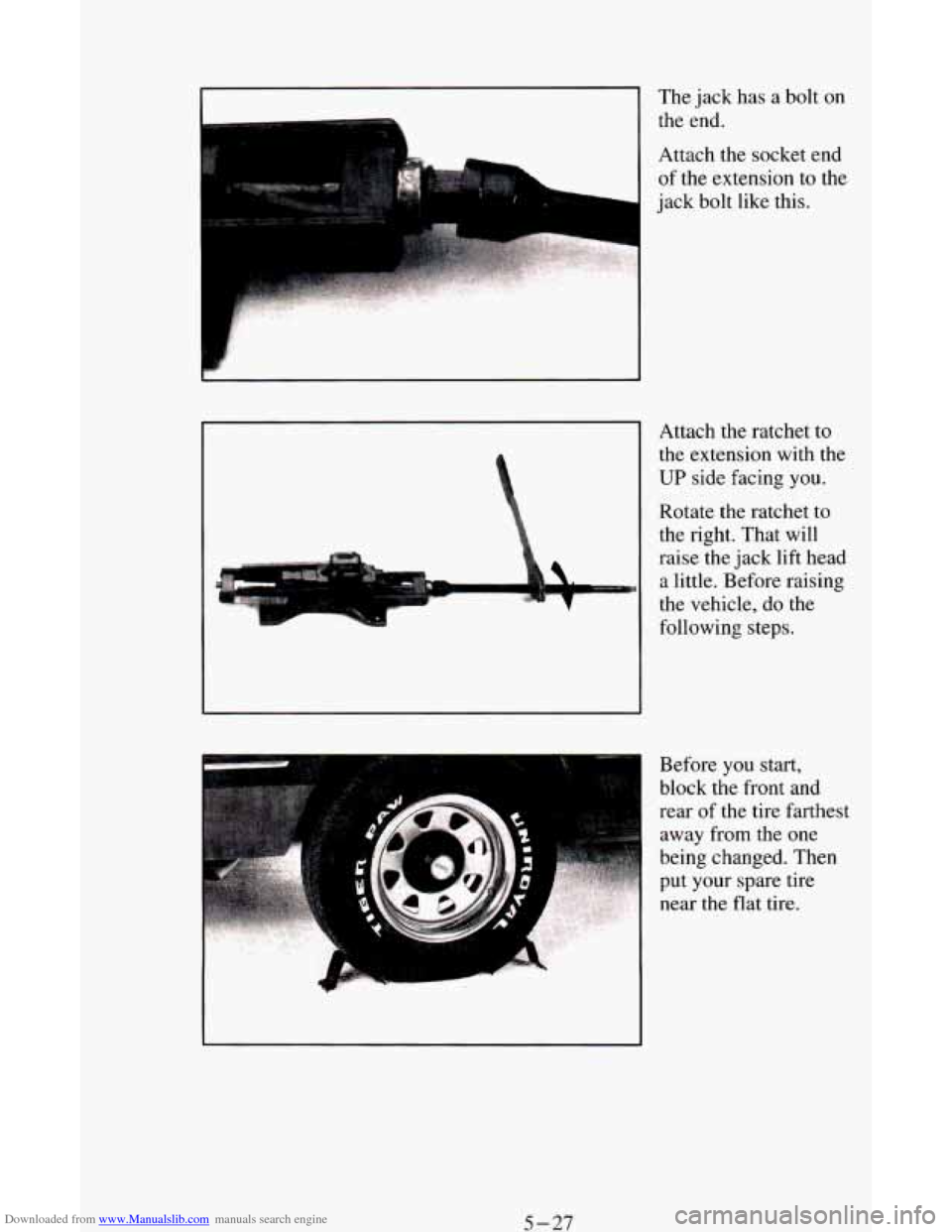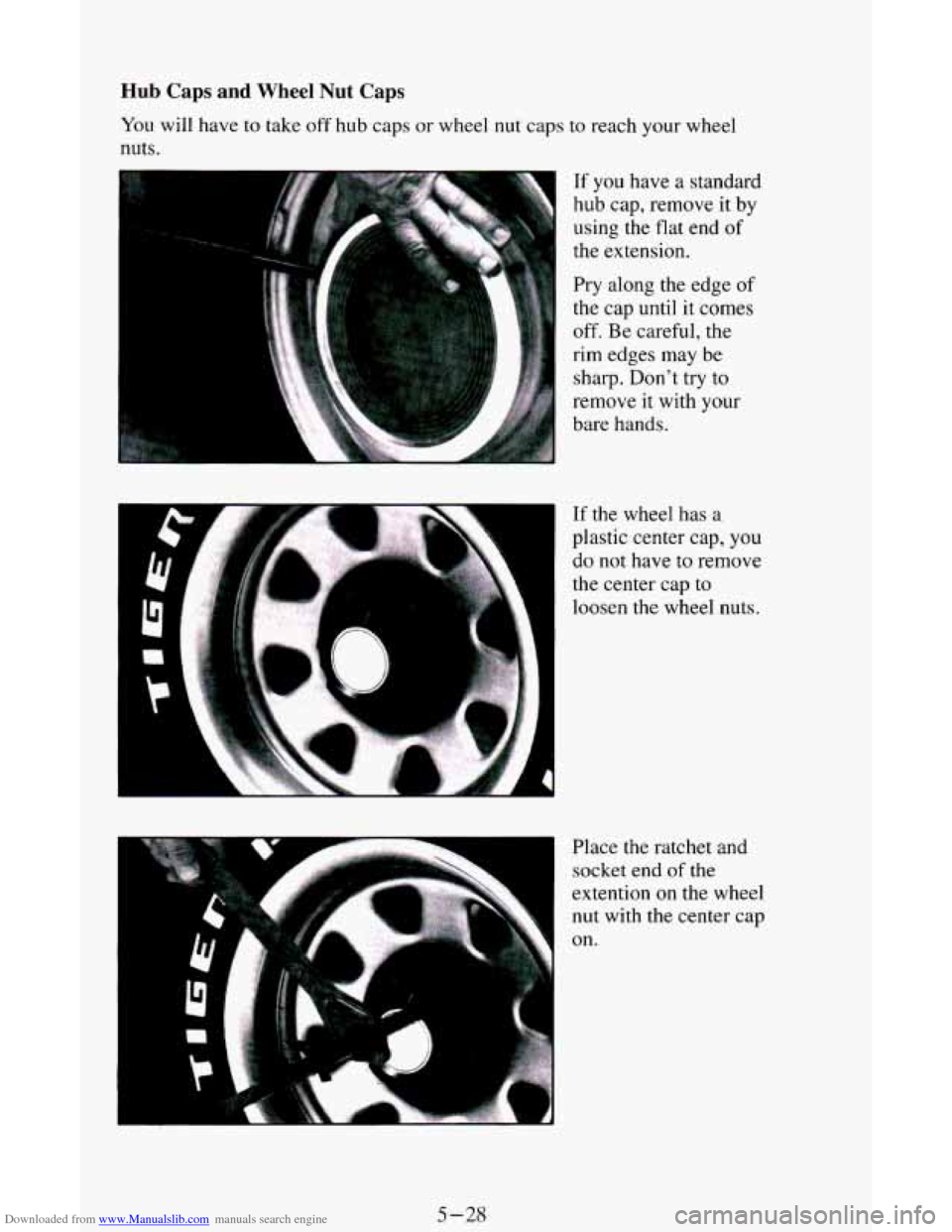CHEVROLET ASTRO CARGO VAN 1995 2.G Owners Manual
ASTRO CARGO VAN 1995 2.G
CHEVROLET
CHEVROLET
https://www.carmanualsonline.info/img/24/8008/w960_8008-0.png
CHEVROLET ASTRO CARGO VAN 1995 2.G Owners Manual
Trending: door lock, timing belt, air conditioning, light, wheel alignment, wheelbase, windshield wipers
Page 191 of 342
Downloaded from www.Manualslib.com manuals search engine I
4. Then fill the coolant recovery tank to ADD.
5. Put the cap back on the coolant recovery tank, but leave the radiator
pressure cap
off.
6. Start the engine and let it run until you can feel the upper radiator hose
getting hot. Watch out for the engine fan.
5-19
Page 192 of 342
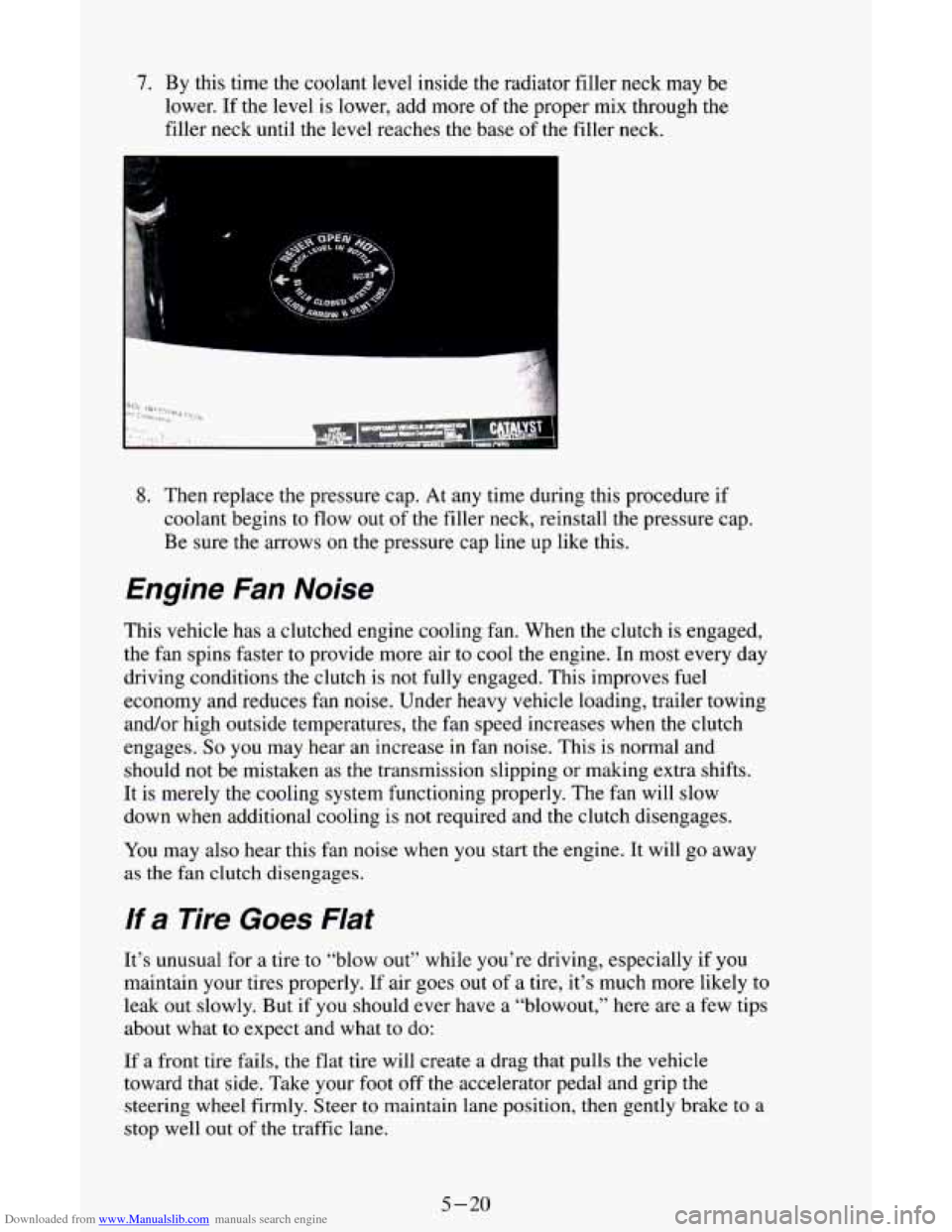
Downloaded from www.Manualslib.com manuals search engine 7. By this time the coolant level inside the radiator filler neck may be
lower.
If the level is lower, add more of the proper mix through the
filler neck until the level reaches the base
of the filler neck.
8. Then replace the pressure cap. At any time during this procedure if
coolant begins to flow out of the filler neck, reinstall the pressure cap.
Be sure the arrows on the pressure cap line
up like this.
Engine Fan Noise
This vehicle has a clutched engine cooling fan. When the clutch is engaged,
the fan spins faster to provide more air to cool the engine. In most every day
driving conditions the clutch is not fully engaged. This improves fuel
economy and reduces fan noise. Under heavy vehicle loading, trailer towing
and/or high outside temperatures, the fan speed increases when the clutch
engages.
So you may hear an increase in fan noise. This is normal and
should not be mistaken
as the transmission slipping or making extra sh
It is merely the cooling system functioning properly. The fan will slow
down when additional cooling is not required and the clutch disengage .ifts.
S.
You may
also hear this fan noise when you start the engine. It will go away
as the fan clutch disengages.
If a Tire Goes Flat
It’s unusual for a tire to “blow out” while you’re driving, especially if you
maintain your tires properly.
If air goes out of a tire, it’s much more likely to
leak out slowly. But if you should ever have a “blowout,” here are a few tips
about what
to expect and what to do:
If
a front tire fails, the flat tire will create a drag that pulls the vehicle
toward that side. Take your foot off the accelerator pedal and grip the
steering wheel firmly. Steer
to maintain lane position, then gently brake to a
stop well out of the traffic lane.
5-20
Page 193 of 342
Downloaded from www.Manualslib.com manuals search engine A rear blowout, particularly on a curve, acts much like a skid and may
require the same correction you’d use in
a skid. In any rear blowout, remove
your foot from the accelerator pedal. Get the vehicle under control by
steering the way you want the vehicle
to go. It may be very bumpy and
noisy, but
you can still steer. Gently brake to a stop, well off the road if
possible.
If a tire goes flat, the next part shows how to use your jacking equipment
to
change a flat tire safely.
Changing a Flat Tire
If a tire goes flat, avoid further tire and wheel damage by driving slowly to a
level place.
Turn on your hazard warning flashers.
A. Flat Tire
B. Blocked Tire
5-21
Page 194 of 342
Downloaded from www.Manualslib.com manuals search engine The following steps will tell you how to use the jack and change a tire.
Jack Storage
Thejacking equipment you'll need is stored by your vehicle's rear doors,
along the passenger side
wall.
Remove your jack
cover
by turning the
plastic wing
nut
counterclockwise.
Lift
up on the latch
and pull
the jack cover
off
e
Remove the wheel
blocks and jack
by
turning the wing nut
.- counterclockwise. *b "' "" 1 Remove the wing nut
and washer then pull
the wheel blocks and
jack
off the bolt.
5-22
Page 195 of 342
Downloaded from www.Manualslib.com manuals search engine c
Remove the ratchet
and extension by
turning the wing nut
counterclockwise.
Remove the wing nut
and retainer and take
out the ratchet and
extension.
Jacking Equipment Storage
1. Nut
2. Washer
3. Wheel Blocks
4. Jack Lift Head
5. Jack
6. Jacking Instructions Tag
7. Nut
8. Retainer
9. Ratchet
10. Extension
11. Bolt
5-23
Page 196 of 342
Downloaded from www.Manualslib.com manuals search engine Spare Tire
Your spare tire is
stored underneath the
rear
of your vehicle.
You will use the
ratchet and extension
to lower the spare tire.
1 NOTICE:
Never remove or restow a tire frodto a stowage position under
the vehicle while the vehicle is supported by a
jack. Always
tighten the tire fully against the underside
of the vehicle when
restowing.
The ratchet has an UP
side.
5-24
Page 197 of 342
Downloaded from www.Manualslib.com manuals search engine And a DOWN side.
To Remove the Spare Tire
Attach the ratchet,
with the
DOWN side
facing you,
to the
extension. The
extension has a socket
3
Put the flat end of the extension on an angle through the hole in the rear
door frame, above the bumper. Be sure the flat end connects into the hoist
shaft.
Turn the ratchet
counterclockwise to
- lower the spare tire to
the ground, Keep
turning the ratchet
until the spare tire can
be pulled out from
under the vehicle.
5-25
Page 198 of 342
Downloaded from www.Manualslib.com manuals search engine When the tire has been lowered, tilt the
retainer at
the end of
the cable and pull it
through the wheel
opening. Pull the tire
out from under the
vehicle.
I NOTICE:
To help avoid vehicle damage, do not drive vehicle before cable
is restored.
Changing the Tire
5-26
Page 199 of 342
Downloaded from www.Manualslib.com manuals search engine The jack has a bolt on
the end.
Attach the socket end
of the extension to the
jack bolt like this.
Attach the ratchet to
the extension with the
UP side facing you.
Rotate the ratchet to
the right. That will
raise the jack lift head
a little. Before raising
the vehicle, do the
following steps.
Before
you start,
block the front and
rear of the tire farthest
away from the one
being changed.
Then
put your spare tire
near the flat tire.
5-27
Page 200 of 342
Downloaded from www.Manualslib.com manuals search engine Hub Caps and Wheel Nut Caps
You will have to take off hub caps or wheel nut caps to reach your wheel
nuts.
i
If you have a standard
hub cap, remove it by
using the flat end
of
the extension.
Pry along the edge
of
the cap until it comes
off. Be careful, the
rim edges may be
sharp. Don’t try
to
remove it with your
bare hands.
If the wheel has a
plastic center cap, you
do not have to remove
the center cap to
loosen
the wheel nuts.
Place the ratchet and
socket end
of the
extention on the wheel nut with the center cap
on.
5-28
Trending: engine, driver seat adjustment, water pump, radio, circuit breakers, air suspension, heating
